At the beginning of the occupation, it was enough for the average blackmailer to blackmail one Jew to live like a king for a month! The Jews, on the other hand, paid any amount just to postpone the death sentence. As long as they had what.
Theoretically, people of Jewish nationality had a chance to survive outside the ghetto walls, and many actually managed to do so. Poles helping them, providing apartments or cellars, providing food, often completely selflessly, were not lacking. 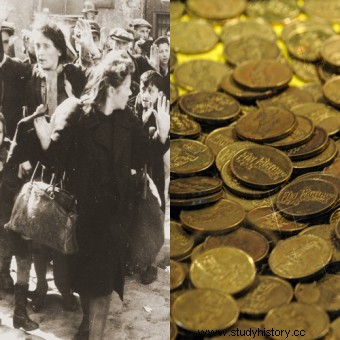
The thing is that even they were unable to protect both those in hiding and themselves from the blackmailers - a real scourge of the occupation city of Warsaw. You had to pay dearly for the right to live.
They took money, shoes, coat
Władka Meed described quite a typical situation in her memoirs:
Mrs. Brzeska, a friendly, righteous and compassionate Polish woman, who lives at 8 Topiel Street, gave shelter to five Jews. First, a mother and her son, a former policeman, stayed with her. They both had typical Jewish features and had to hide all the time.
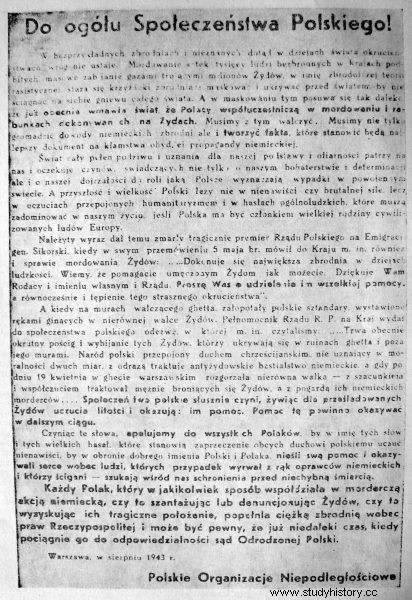
Although the Polish Underground State treated blackmail as a collaboration with the enemy, many people were tempted by the prospect of easy profit. The photo shows a Żegota leaflet condemning the blackmailing of Jews (source:public domain).
One day blackmailers showed up. They were obviously well informed as they headed straight to the room where the elderly woman and her son were staying. The attackers took the money and jewelry and then they assured the frightened landlady that they would not be bothering her anymore and that the Jews might be hiding.
The humanitarianism shown to depart, ultimately lost to the prospect of easy earnings. Szmalcownicy returned to Topiel Street after a few weeks and plundered literally everything this time . The mother, recognizing that she was only a burden for her son in this situation, committed suicide.
Having caught a Jew, they immediately demanded money from him, and if he did not have enough, they stripped the victim of his coat, shoes, everything which only had some value. Szmalcowniks could be found everywhere. They prowled in residential neighborhoods, persecuted people in the streets and in factories - Meed supplemented her memories.
She wasn't exaggerating. Gunnar S. Paulsson loosely calculated that only in two years there were probably about 50-100 thousand acts of blackmail which is 2-4 thousand per month. The enormous shooting in these figures is precisely due to the fact that seizures were so common that no one counted them anymore.
Money or life!
Until the Jews were still able to move freely in the streets, the attacked people reported themselves to the police. For example, a report by a certain Jakub Adamczyk, a policeman from the IX PP's police station, has survived. He noted on March 31, 1940:
While on duty on Marszałkowska Street, at the I station at At 9.30 a Jew called Stryk Wolf (...) told me that the person he had pointed with his finger had stopped the one named on Marszałkowska Street and after being arrested forced him to go with him to the nearest gate under the threat of shooting .
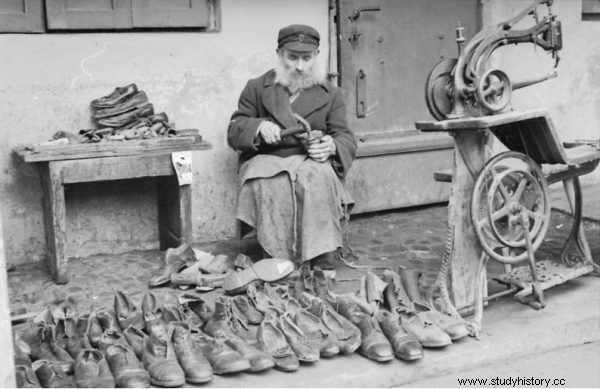
Attempts were made to blackmail those who were not hiding with imaginary accusations. In the photo:a Jewish shoemaker at work in 1941 (source:Bundesarchiv, license:CC BY-SA 3.0 de).
After entering the gate in question, the subject turned him facing the wall and told him in German that he was in the service of the Gestapo and that he knew that Żydek Stryk traded in dollars and was forced to escort him to the local Gestapo. The Jew, Stryk, replied that he did not trade in dollars and that he might not be afraid. After this answer the subject demanded PLN 1000 from Stryk, otherwise he will lead to the Gestapo or he will shoot at Stryk's place.
As in the spring of 1940, a thousand zlotys was a greatly inflated amount. During this period, it was possible to buy it for several hundred zlotys. The blackmailer fee increased to a thousand more or less a year later, although sometimes it was a thousand, understood quite perversely. - If you want us to let you go, but for 3000, a thousand per head. Then we'll let you go - she recalled one of her occupation adventures, Meed.
After the so-called "great deportation from the ghetto" even five or six thousand did not seem excessive . Just before the outbreak of the Warsaw Uprising, the standard fee stabilized at around two and a half thousand zlotys.
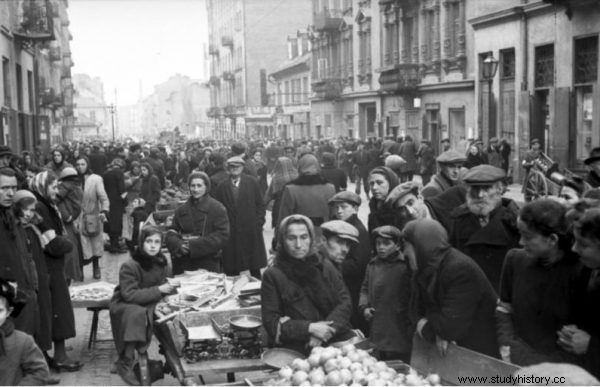
Food prices in occupied Warsaw rose by leaps and bounds. Where to get money for food and constant bribes? (source:Bundesarchiv, license:CC BY-SA 3.0 de).
For a bribe, for bread…
What did this mean in practice? It is very difficult to say what the purchasing value of these forced bribes was, because the prices of goods were rising at a completely absurd pace . For example, a kilogram of beef in July 1941 cost 8.92 zlotys, and in July 1943 it was ten times the price - 82.89 zlotys. And this was the trend for all foods.
We are talking about black market prices, of course, but in the case of Jews (and Poles as well), no other prices can be said. The official food rationale for them only allocated 184 calories, while the Poles received 669, and the Germans 2613. In order not to starve to death, considerable amounts and a lot of cunning were needed.
By buying their lives from blackmailers, Jews often deprived themselves of the means to sustain vegetation. . It is hard to say, however, that they had any choice in this matter. The vision of immediate denunciation or even execution was a more real threat in a given situation than the specter of death by starvation.
One blackmailed Jew - money for the whole month
Szmalcownik, on the other hand, was quite well positioned considering the conditions of the occupation . Forcing a thousand zlotys, he collected the equivalent of all fees (rent, electricity, taxes ... etc.) of an average Varsovian for six months. For comparison, the absolute cronies of the Home Army underground - elite subversive units - earned 1,500 zlotys a month. A little less, 1200-1400, then kings of life - smugglers and food smugglers.
At that time, the average clerk earned 250-270 zlotys, and the worker 1.16 zlotys per hour, or about 232 zlotys a month. And we are only talking about men - women and adolescents received many times less. So it turns out that one Jew who was blackmailed in 1941 provided the blackmailer with an average four-month salary for a worker.
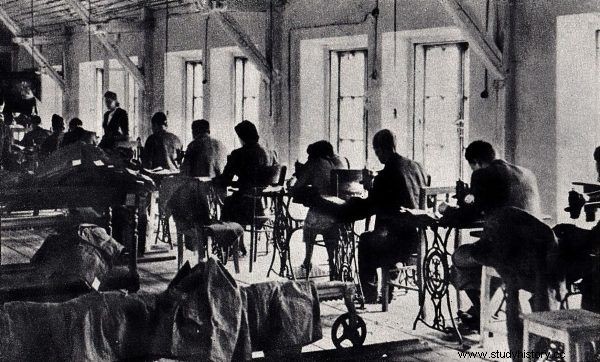
The average salary of a worker in occupied Warsaw was not enough to meet basic needs. Szmalcownik lived on a completely different level (source:public domain).
Gangsters, bastards and regular bastards
A Jew hiding outside the ghetto had little chance of avoiding contact with a blackmailer. This practice took many forms. There were specialized gangs, but there were also individual blackmailers who were content with smaller amounts. There were also "occasional" blackmailers who treated it as an easy opportunity to meet their immediate needs.
Mojżesz Chonczyński talked about the latter. He and his brother were arrested on Koszykowa Street by a random passer-by who accused them of possessing anti-German leaflets and threatened to escort to the Gestapo. He asked how much money we had with us, because at the moment he needs 200 zlotys - noted Chonczyński.
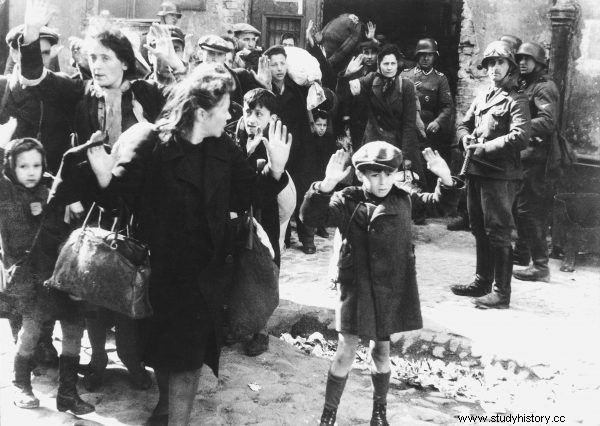
In the face of the ruthless greed of blackmailers, the Jews were completely helpless ... (source:public domain).
Finally, it also happened that Jews had to pay bribes to people who were not basically blacksmiths, but simply channels using their position . One such person was, for example, a policeman on duty at the wall of the Warsaw ghetto, which Anna Mróz wrote about:
Small children walked through the hole in the wall, because only such children could fit in the opening of the wall that divided Warsaw into a ghetto on one side and the so-called Aryan side on the other . We called the gendarme of the one who had a strangely Jewish long nose and who could be bribed Josef Hacadyk which in Hebrew means "almost holy."
He couldn't sit down to breakfast unless he shot some "cockroaches" as he called the kids because of their black hair. When the bodies were cooling down, he ate breakfast with appetite and the families in the ghetto waited in vain for their only breadwinners.
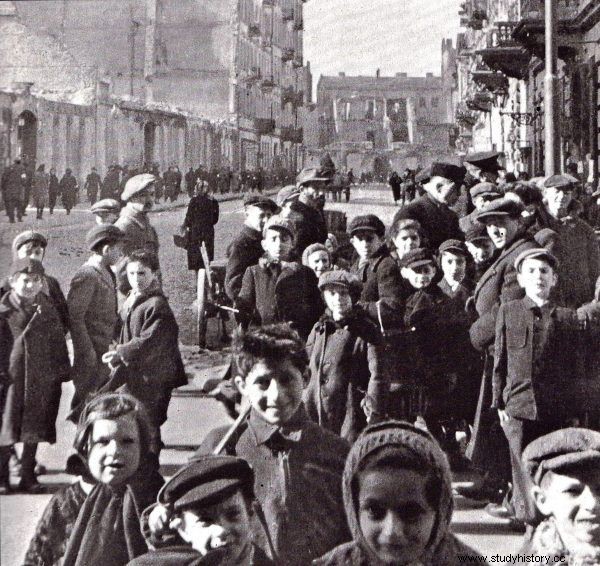
Jews had to pay not only to "professional" blackmailers, but also to sewers like Josef Hacadyk, who shot children passing through a hole in the ghetto wall (or, as he called them, "cockroaches") (source:public domain).
Even the biggest scum has an advantage. Hacadik had one - was cheap. Anna Mróz and her husband paid him only twenty zlotys for closing a blind eye when they illegally joined the twenty-strong team of Jews leaving the ghetto to work on the Aryan side. On the other hand, he may have compensated for the low price with the amount of bribes, because he certainly did not lack the opportunity to take them.
Bayonian sums
The cost of life varied depending on the victim's status. And wealthy Jews were not anonymous in Warsaw. Specialized gangs with paid informants in the city knew exactly where the most cash was.
Łucja Szpiro wrote that she bought two furs with a total value of PLN 1,500. 200,000 were requested from Krystyna Siewierska, and after a long bargain, the attackers were satisfied with 80,000. In turn, from Adolf Berman - Żegota's secretary, and after the war a Knesset deputy - demanded 500,000 which he managed to bring down to 200,000.
However, these were exceptions. The basic rates ranged from a thousand to several thousand zlotys, or their equivalent in the goods. For Jews deprived of the possibility of earning money, even such sums practically meant death - if they did not manage to find a helping hand.
The worst part, however, was not so much the amount of bribes paid to blackmailers as the prevalence of the practice itself. Jewish historian Emanuel Ringelblum, the creator of the Warsaw Ghetto Archive, himself murdered in 1944, wrote on an ongoing basis in his "Polish-Jewish Relations during World War II":
Blackmailers and blackmailers are the eternal bane of Jews on the Aryan side . There is literally no Jew above or below the surface who has not dealt with them once or several times and has not had to buy more or less money from them .
